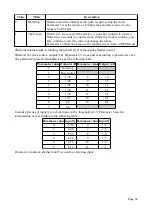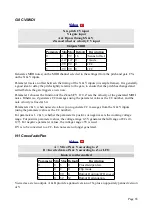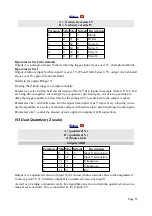
X is clock input
Y is modify input
Z sets the randomness
A is unipolar output
B is bipolar output or trigger
Receives MIDI
Parameter Min Max Default
Description
0
0
1
0
Direction.
1
1
32
8
Length.
2
0
31
0
Slew rate.
3
-40 40
40
Output attenuverter.
4
-40 40
0
Offset.
5
0
15
0
MIDI clock divisor.
6
0
5
0
Output B signal.
This algorithm generates random CVs via the popular rotating shift register method. The joy of this
method is that it generates a loop of CVs, with a controllable likelihood of change, including the
possibility to lock the loop so it does not change.
X is the clock input. Any clock pulse in excess of 1V can be used. On each rising edge the shift
register rotates and a new CV is output. On each rotation, there is the possibility that one bit of the
shift register will be flipped, changing the pattern. The likelihood of a flip is set by Z. When Z is
zero there is a 50% chance that the bit will flip, which is the most random setting. As Z rises, the
chance of a flip reduces, until at around 2V the chance of a flip hits zero and the pattern is
effectively locked. Conversely, as Z goes negative, the chance of a flip goes up, reaching 100% at
around -2V. This also effectively locks the pattern, but at twice the length (since it is alternating
between the locked pattern and its inverse). When Z crosses the ±2V boundaries, in either direction,
the display shows "**" for a short while to let you know that the pattern has been locked or
unlocked.
Input Y allows for modification of the sequence, even when the loop is locked. If input Y is above
1V, the bit will always be flipped on a clock pulse, regardless of the setting of Z.
Output A is the random pattern interpreted as a unipolar CV (i.e. it is always a positive voltage).
Output B is the random pattern interpreted as a bipolar CV (i.e. it can swing both positive and
negative)
or
a trigger output, according to parameter 6.
Parameter 6 value
Output B
0
Bipolar CV.
1
Trigger if the current bit is high.
2
Trigger if the current bit is low.
3
Trigger if the current bit changes.
4
Trigger if the current bit change from low to high.
5
Trigger if the current bit change from high to low.
Parameter 0 sets the direction of rotation. The two directions have a different sound to the patterns
Page 54






































